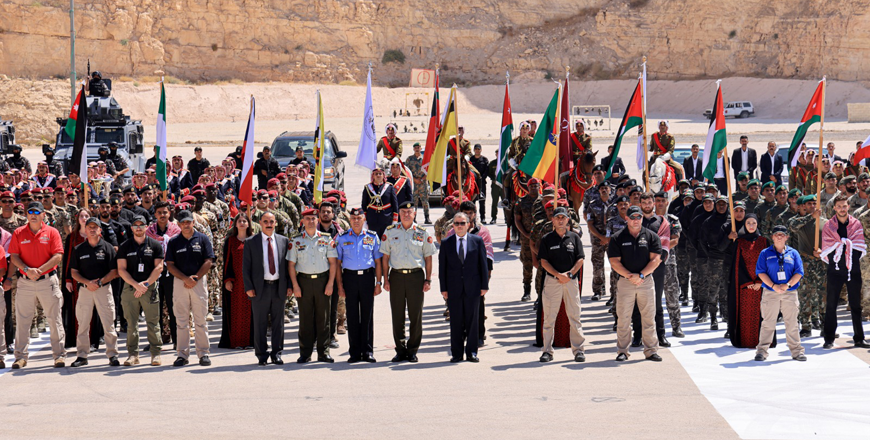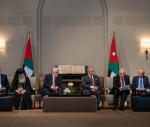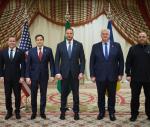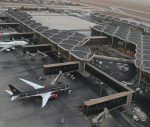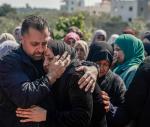You are here
When the boys come back from Syria
By Linda Hindi - Jun 08,2014 - Last updated at Jun 08,2014

AMMAN — “When you talk about security in the region, Jordan is in the eye of the tornado,” Brigadier General Aref Al Zaben, CEO of the King Abdullah II Special Operations Training Centre (KASOTC), said.
The military commander made the comment in an exclusive interview where he highlighted Jordan’s prowess in the field of combating extremist ideology and the militaristic training at the KASOTC facility. (see KASOTC profile)
“We need to be ready for when the boys come back from Syria,” he said, referring to Jordanians who have joined anti-Assad fighting in a war only a couple of hours drive away from the Kingdom’s capital.
Syria border ‘given priority’ now
In a country lodged between Iraq, Saudi Arabia, Israel and Egypt, security is tight and stretched thin, but it is the “long border with Syria (around 370km) that is now given particular attention by Jordan Armed Forces (JAF) and the General Intelligence Department (GID).
KASOTC, which is owned by JAF, is an international training centre that opened its doors five years ago and has since trained elite military and law enforcement units in counterterrorism tactics, irregular warfare and special operations from over 50 nations around the world.
The facility was built to prepare Jordan and its allies for terror threats in the midst of the world’s current unpredictable security environment.
‘Jordanian way works’
Brig. Gen. Zaben explained that making the will of the people the primary target by using non-kinetic warfare, is of rising importance in the wake of Jordan’s latest burden: the returning fighters from Syria.
“These young men go to Syria thinking they are doing the right thing by helping fellow Muslims, then meet with extreme Shiite and Sunni groups who distort their religion and thinking,” he said.
Zaben, who has been deeply involved in counterterrorism through Jordan’s military since 1987 believes in the feasibility of the Jordanian method, through which extremist group members are targeted to explain to them religious doctrine in a way that challenges ideologist views.
“The root cause is misunderstood religion… Often people with little understanding of Islam believe that if an imam can recite the Koran in a beautiful manner then he is a scholar in religion... Some groups misinterpret or deliberately misguide others to serve their political agendas,” he said.
Zaben noted that the intellectual approach is also very effective in real combat situations. In 2010, a Jordanian imam, armed with Islamic knowledge was deployed with a Ranger battalion to challenge Taliban views in eastern Afghanistan.
The imam was able to speak with Afghan elders, villagers and members of the Taliban in a civilised manner without resorting to polemics.
Jordanian soldiers are trained before deployment as well. “Soldiers need to believe in a doctrine for it to be implemented on the ground; they too need to know how to detect and respond to extreme thinking… this is how you control the winning hand,”Zaben, who was in command of the operation in Afghanistan, said.
He further explained that Jordan is well aware that extreme ideology is a core problem and has long been spreading the message of “moderation” through initiatives like “The Amman Message” and “A Common Word” which are documents that have been widely disseminated to spread the message of the true and peaceful nature of Islam.
‘Syria is different’
But what remains unknown is if these methods are enough as world experts are calling out that what is happening in Syria is different.
Bruce Riedel, a former CIA senior analyst, wrote in a recent article that Syria is “all but certain to be an even larger factory for extremism than Afghanistan”.
Similarly, Richard Barrett, author of a report released last week called “Foreign Fighters in Syria” and senior vice president of the Soufan Group, an international consultancy that provides security intelligence services to governments and organisations, reports that advances in technology, communications, travel and tactics mean that even a very small percentage of returning foreign fighters could have a major impact on their homelands.
Speaking to The Jordan Times from New York, the former MI6 secret intelligence officer who headed the UN’s Monitoring Team on Al Qaeda and the Taliban and former Director of Global Counter Terrorism Operations in the US said the situation is “really, really bad for Jordan”.
The extremism expert explained that the Kingdom is in a “particularly difficult position” since it contains a potent mixture of social divides, Al Qaeda elements, refugee camps and a history of mistrust “as Jordan and Syria are traditional enemies” he said, adding “of course not to forget, [slain terror chieftain in Iraq Abu Musab] Zarqawi was Jordanian”.
Barrett, who served as a British diplomat in Jordan for a few years from 1997, said that the major difficulty is determining who is a suspect, as the majority of returnees have no desire to harm their homeland. “It requires huge resources and Jordan has an awful lot of movement but not a lot of resources,” he said adding that “the GID is very efficient but it has a hell of a challenge”.
To illustrate, estimates published in The Jordan Times derived from hard-liner Islamist sources put the number of Jordanians who have joined the fight at 2,000 plus, with fighters trickling back home week after week. A senior government source ,who wished to remain anonymous, put the figure at just over 1,000 fighters.
The Kingdom’s woes are compounded by the fact that its population has surged an additional 10 per cent as a wave of Syrians, from different spectrums, has taken refuge on Jordanian land.
“... as Syria becomes more permanently divided, extremist groups will put down deeper roots and establish safe havens... .The longer young people spend in refugee camps, or otherwise displaced from home and school, the more vulnerable they will be to sectarian or other terrorist recruiters,” the Soufan report states.
The international scope
The full scale in numbers is alarming; Barrett’s telling report says that over 12,000 foreign fighters from at least 81 countries have gone to Syria since the conflict began and although figures cannot be precise this compares with estimates of 10,000 for the whole ten-year period of the Afghan “jihad” against Soviet occupation plus the period of Taliban rule from 1996 to 2001, and the numbers continue to rise.
The report makes plain that “the treatment of returning foreign fighters by the authorities of their home states will have an important impact on their future behaviour”.
The global response has varied.
In late March, Saudi Arabia issued a final warning with a two-week grace period for jihadists to return home; its interior minister announced that returnees will be provided with “a special counselling programme” to assist them in reintegration into society. A few hundred Saudi nationals have accepted the offer.
By contrast, the Netherlands has banned certain individuals from returning home and used ankle bracelets to track those who have returned from Syria. Some EU countries have also discussed cutting off individuals’ access to government benefits such as healthcare and other social services if they’ve participated in the jihad in Syria, according to an article posted on the Washington Institute website.
Law is there, so is the threat
The fact remains that only time can tell the scale of impact of returned fighters who have been exposed to sustained radicalisation from the ugly and highly complicated war next door. Jordan’s soft-hand approach to reach out to returnees seems to be taking a left turn amidst heightened threats.
Recently, the Lower House of Parliament passed a controversial anti-terror bill granting the state broad powers to detain and try citizens suspected of any affiliation with terrorist groups abroad.
In a Haaretz article published in April, Mohammed Shalabi, a Jordanian Salafist leader better known here as Abu Sayyaf, who encouraged militants to go and fight in Syria, said the earlier official stance of tacit tolerance had ended.
The article quoted a source familiar with the policy of Jordan’s intelligence services and who spoke on condition of anonymity as saying: “We turned a blind eye to you going, but if you return we will catch you and lock you up.”
The Jordan Times recently reported Abu Sayyaf warning that “unless we arrive at a peaceful solution [among Islamists fighting each other in Syria], we may see bloodshed from Syria all the way to Jordan and that is a threat no one can contain.”
KASOTC’s CEO concedes that mitigating an attack in Jordan is “a great challenge” which Jordan needs to be prepared for.
“Whichever way you look at it, it goes back to pushing forward the Amman Message,” the general said.
“Who is qualified to issue a fatwa about war? This is what the boys need to know before running to fight and this is what the message explains,” Zaben told The Jordan Times.
Related Articles
AMMAN — Chairman of the Joint Chiefs of Yousef Huneiti on Sunday attended the launch of the 13th annual international Warrior Competition at
AMMAN – Chairman of the Joint Chiefs-of-Staff Lt. Gen.
In the midst of blasted-out canyons, just north of Amman, elite military and law enforcement units from Jordan and around the world are learning advanced mission tactics in a massive facility that simulates real-world war conditions including live-fire weapons.


